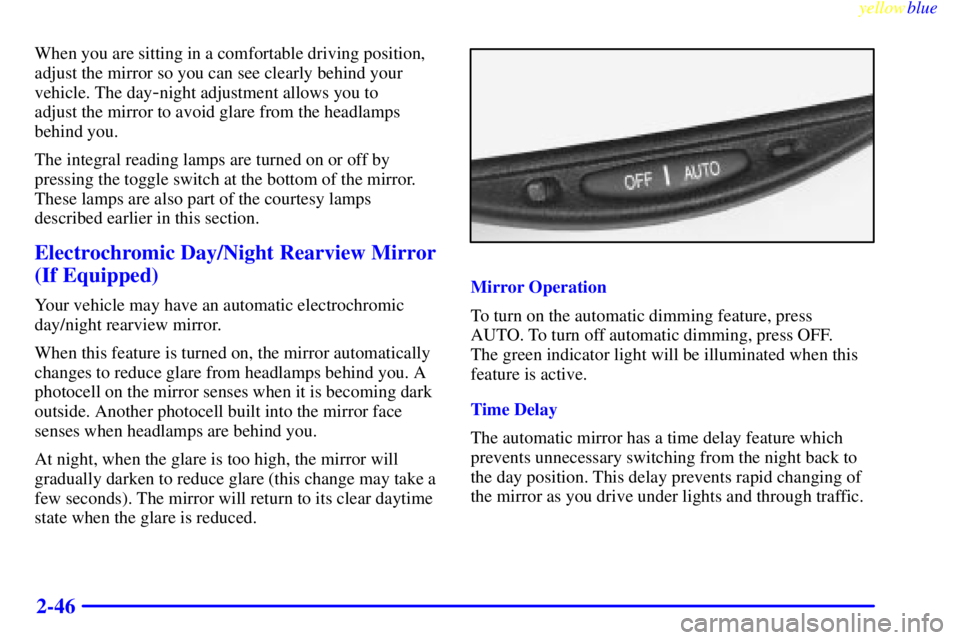Page 99 of 368

yellowblue
2-43 Illuminated Entry (If Equipped)
Press the UNLOCK button on the remote keyless entry
transmitter (if equipped) and the interior courtesy lamps
will turn on and stay on for up to one minute. The lamps
will turn off immediately by pressing the LOCK button
on the remote keyless entry transmitter, starting the
engine or activating the power door locks.
Delayed Entry Lighting
When you open the door, the interior lamps will turn on.
When you close the door with the ignition off, the
interior lamps will stay on for 25 seconds or until the
ignition is turned to an on position. Note that locking the
doors will override the delayed entry lighting feature
and the lamps will turn off right away.
Theater Dimming
This feature allows for a three to five-second fade out of
the courtesy lamps instead of immediate turn off.
Delayed Exit Lighting
With this feature, the interior lamps will turn on and stay
on for up to 25 seconds after you remove the key from
the ignition. This will give you time to find the door pull
handle or lock switches.
Perimeter Lighting (If Equipped)
When the UNLOCK button on the remote keyless entry
transmitter is pressed, the headlamps, parking lamps,
back
-up lamps and cornering lamps will turn on if it is
dark enough outside according to the twilight sentinel.
If your vehicle is not equipped with twilight sentinel
and perimeter lighting is active, the lights will turn on
whenever the UNLOCK button on the transmitter
is pressed.
Personal Choice Programming
This feature can be programmed in the on or off mode
for each transmitter.
To turn the feature off:
1. Turn the ignition key to OFF.
2. Press and hold LOCK on the power door lock switch
throughout this procedure. All the doors will lock.
3. Press the instant alarm on the remote keyless entry
transmitter. Perimeter lighting remains on at this
time and the horn will chirp two times.
Page 102 of 368

yellowblue
2-46
When you are sitting in a comfortable driving position,
adjust the mirror so you can see clearly behind your
vehicle. The day
-night adjustment allows you to
adjust the mirror to avoid glare from the headlamps
behind you.
The integral reading lamps are turned on or off by
pressing the toggle switch at the bottom of the mirror.
These lamps are also part of the courtesy lamps
described earlier in this section.
Electrochromic Day/Night Rearview Mirror
(If Equipped)
Your vehicle may have an automatic electrochromic
day/night rearview mirror.
When this feature is turned on, the mirror automatically
changes to reduce glare from headlamps behind you. A
photocell on the mirror senses when it is becoming dark
outside. Another photocell built into the mirror face
senses when headlamps are behind you.
At night, when the glare is too high, the mirror will
gradually darken to reduce glare (this change may take a
few seconds). The mirror will return to its clear daytime
state when the glare is reduced.Mirror Operation
To turn on the automatic dimming feature, press
AUTO. To turn off automatic dimming, press OFF.
The green indicator light will be illuminated when this
feature is active.
Time Delay
The automatic mirror has a time delay feature which
prevents unnecessary switching from the night back to
the day position. This delay prevents rapid changing of
the mirror as you drive under lights and through traffic.
Page 103 of 368
yellowblue
2-47
Cleaning the Photocells
Use a cotton swab and glass cleaner to clean the
photocells when necessary.
Electrochromic Day/Night Rearview Mirror
with Compass (If Equipped)
Your vehicle may have an electrochromic inside
rearview mirror with a compass.
When set in the MIRROR position, this mirror
automatically changes to reduce glare from headlamps
behind you. A time delay feature prevents rapid
changing from the day to night positions while driving
under lights and through traffic.The mirror also includes an eight
-point compass display
in the upper right corner of the mirror face. When on,
the compass automatically calibrates as the vehicle
is driven.
When cleaning the mirror, use a paper towel or similar
material dampened with glass cleaner. Do not spray
glass cleaner directly on the mirror as that may cause
the liquid cleaner to enter the mirror housing. Use a
cotton swab and glass cleaner to clean the photocells
when necessary.
Mirror Operation
Page 106 of 368

yellowblue
2-50 Power Remote Control Mirrors
(If Equipped)
If your vehicle has the
outside power remote
mirrors, the control
is located on the
driver's door.
Move the switch in the middle of the control to choose
the right or left mirror. Push the arrow controls in the
direction you want to move the mirror.
Adjust each mirror so you can see the side of your
vehicle and the area behind your vehicle.
Convex Outside Mirror
Your passenger's side mirror is convex. A convex
mirror's surface is curved so you can see more from the
driver's seat.
CAUTION:
A convex mirror can make things (like other
vehicles) look farther away than they really are.
If you cut too sharply into the right lane, you
could hit a vehicle on your right. Check your
inside mirror or glance over your shoulder before
changing lanes.
Automatic Dimming/Heated Outside
Rearview Mirror (If Equipped)
If you have this feature, the outside mirrors will adjust
for the glare of headlamps behind you. This feature is
controlled by the on and off settings on the automatic
electrochromic day/night rearview mirror. See
ªElectrochromic Day/Night Rearview Mirrorº earlier in
this section.
When you operate the rear window defogger, a defogger
also warms the heated driver's and passenger's outside
rearview mirrors to help clear them of ice and snow.
Page 180 of 368

yellowblue
4-16
Here are some tips on night driving.
�Drive defensively.
�Don't drink and drive.
�Adjust your inside rearview mirror to reduce the
glare from headlamps behind you.
�Since you can't see as well, you may need to
slow down and keep more space between you and
other vehicles.
�Slow down, especially on higher speed roads. Your
headlamps can light up only so much road ahead.
�In remote areas, watch for animals.
�If you're tired, pull off the road in a safe place
and rest.
Night Vision
No one can see as well at night as in the daytime. But as
we get older these differences increase. A 50
-year-old
driver may require at least twice as much light to see the
same thing at night as a 20
-year-old.
What you do in the daytime can also affect your night
vision. For example, if you spend the day in bright
sunshine you are wise to wear sunglasses. Your eyes will
have less trouble adjusting to night. But if you're
driving, don't wear sunglasses at night. They may cutdown on glare from headlamps, but they also make a lot
of things invisible.
You can be temporarily blinded by approaching
headlamps. It can take a second or two, or even several
seconds, for your eyes to readjust to the dark. When you
are faced with severe glare (as from a driver who
doesn't lower the high beams, or a vehicle with
misaimed headlamps), slow down a little. Avoid staring
directly into the approaching headlamps.
Keep your windshield and all the glass on your vehicle
clean
-- inside and out. Glare at night is made much
worse by dirt on the glass. Even the inside of the glass
can build up a film caused by dust. Dirty glass makes
lights dazzle and flash more than clean glass would,
making the pupils of your eyes contract repeatedly.
Remember that your headlamps light up far less of a
roadway when you are in a turn or curve. Keep your
eyes moving; that way, it's easier to pick out dimly
lighted objects. Just as your headlamps should be
checked regularly for proper aim, so should your eyes
be examined regularly. Some drivers suffer from night
blindness
-- the inability to see in dim light -- and
aren't even aware of it.
Page 193 of 368

yellowblue
4-29
Run your engine only as long as you must. This saves
fuel. When you run the engine, make it go a little faster
than just idle. That is, push the accelerator slightly. This
uses less fuel for the heat that you get and it keeps the
battery charged. You will need a well
-charged battery to
restart the vehicle, and possibly for signaling later on
with your headlamps. Let the heater run for a while.
Then, shut the engine off and close the window almost
all the way to preserve the heat. Start the engine again
and repeat this only when you feel really uncomfortable
from the cold. But do it as little as possible. Preserve the
fuel as long as you can. To help keep warm, you can get
out of the vehicle and do some fairly vigorous exercises
every half hour or so until help comes.
Recreational Vehicle Towing
You can tow your vehicle behind another vehicle for use
at your destination. Be sure to use the proper towing
equipment designed for recreational towing. Follow the
instructions for the towing equipment.
To tow your vehicle, follow these steps:
1. Put the front wheels on a dolly.
2. Put the vehicle in PARK (P).
3. Set the parking brake and then remove the key.
4. Clamp the steering wheel in a straight
-ahead position
with a clamping device designed for towing.
5. Release the parking brake.
Page 268 of 368
yellowblue
6-32 Headlamps
This procedure is for both the driver's and passenger's
side headlamps.
1. Use a 10 mm hex socket to remove two bolts
retaining the headlamp assembly.
2. Slide the headlamp outboard until the pins are loose.
3. Remove the headlamp assembly to access the bulbs.
Page 270 of 368

yellowblue
6-34
6. Push the new bulb straight onto the retainer.
7. Reverse these steps to replace the bulb assembly.Headlamp Aiming
Your vehicle has a headlamp system equipped with
horizontal and vertical aim indicators. The aim has been
pre
-set at the factory and should need no further
adjustment. This is true even though your vertical and
horizontal aim indicators may not fall exactly on the
ª0º (zero) marks on their scales.
If your vehicle is damaged in an accident, the headlamp
aim may be affected. Aim adjustment may be necessary
if it is difficult to see lane markers (for horizontal aim),
or if oncoming drivers flash their high beams at you (for
vertical aim). If you believe your headlamps need to be
re
-aimed, we recommend that you take it to your dealer
for service; however, it is possible for you to re
-aim
your headlamps as described in the following procedure.
NOTICE:
To make sure your headlamps are aimed
properly, read all the instructions before
beginning. Failure to follow these instructions
could cause damage to headlamp parts.